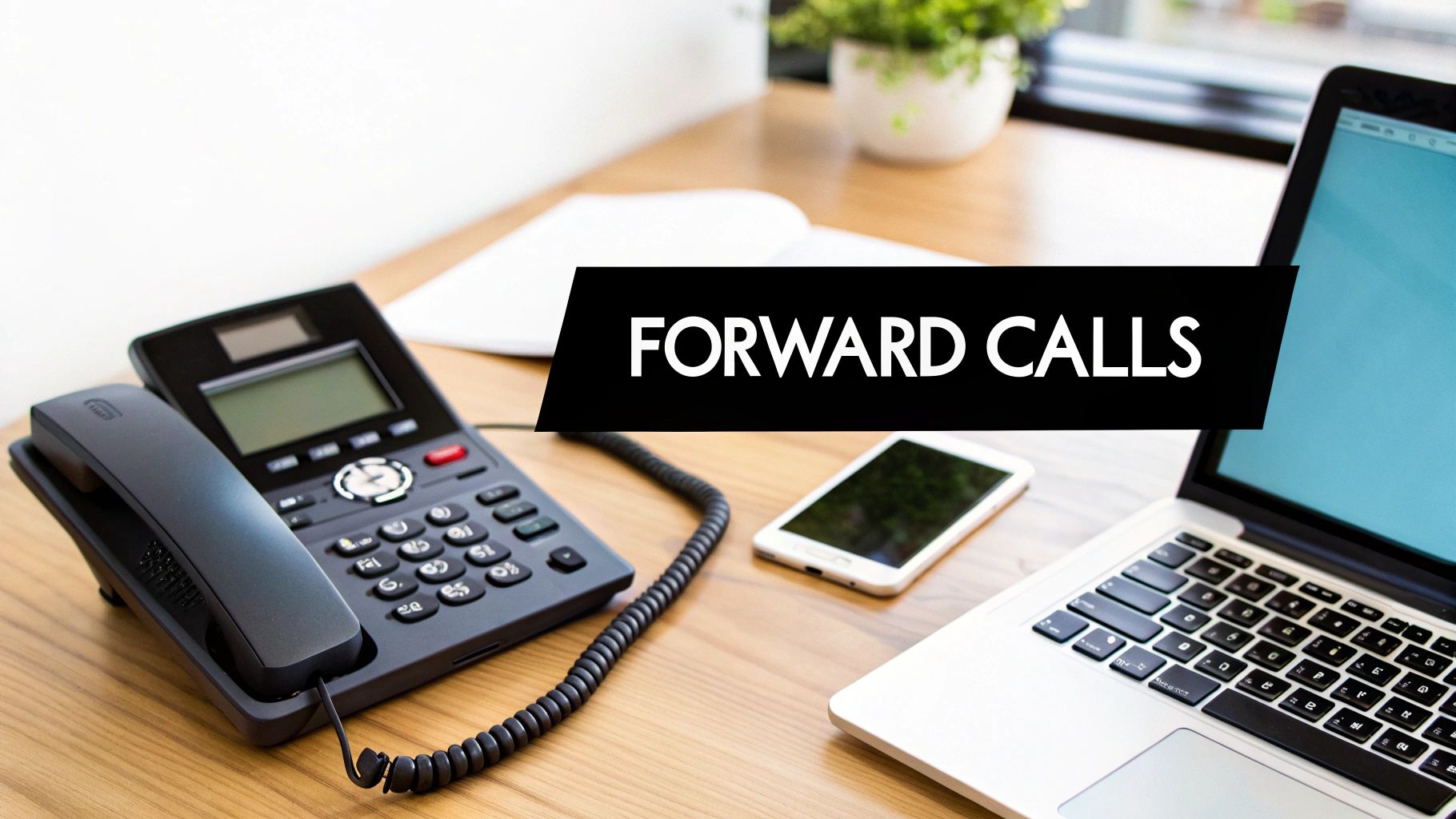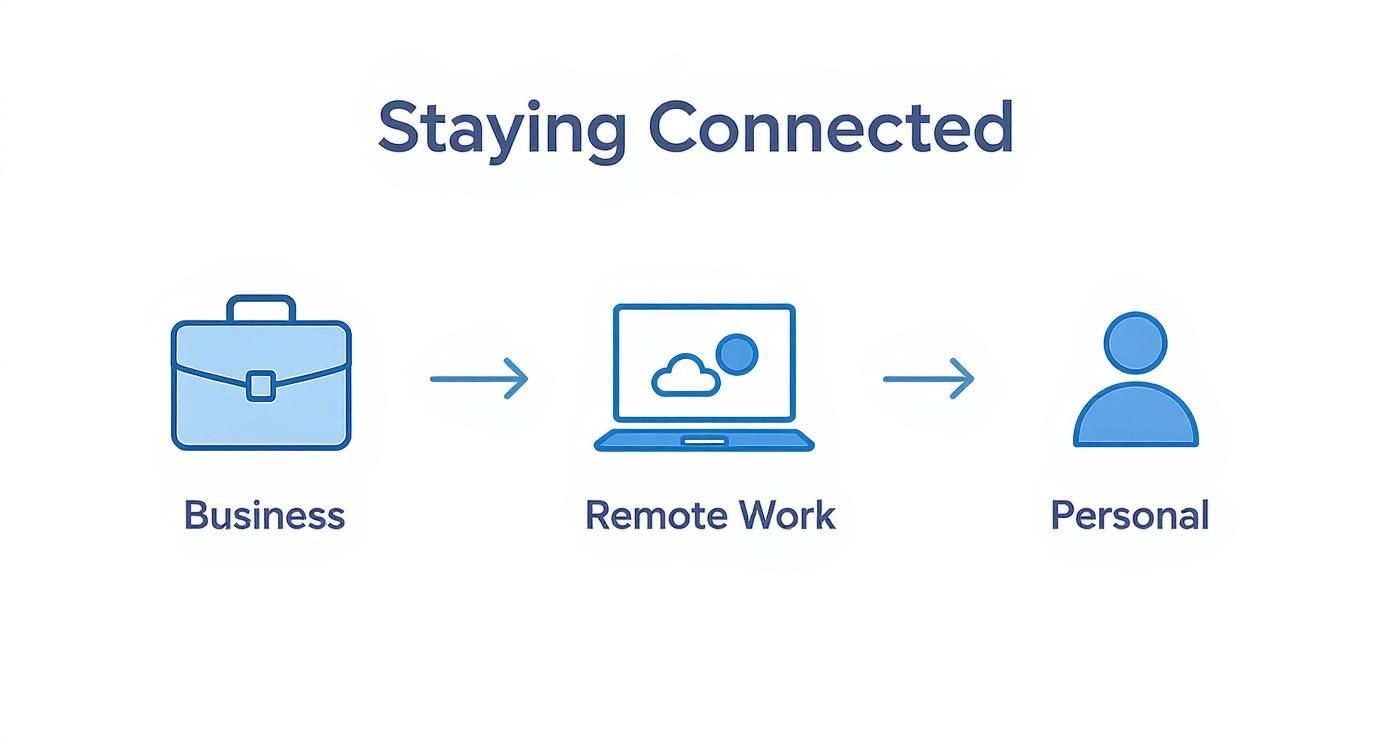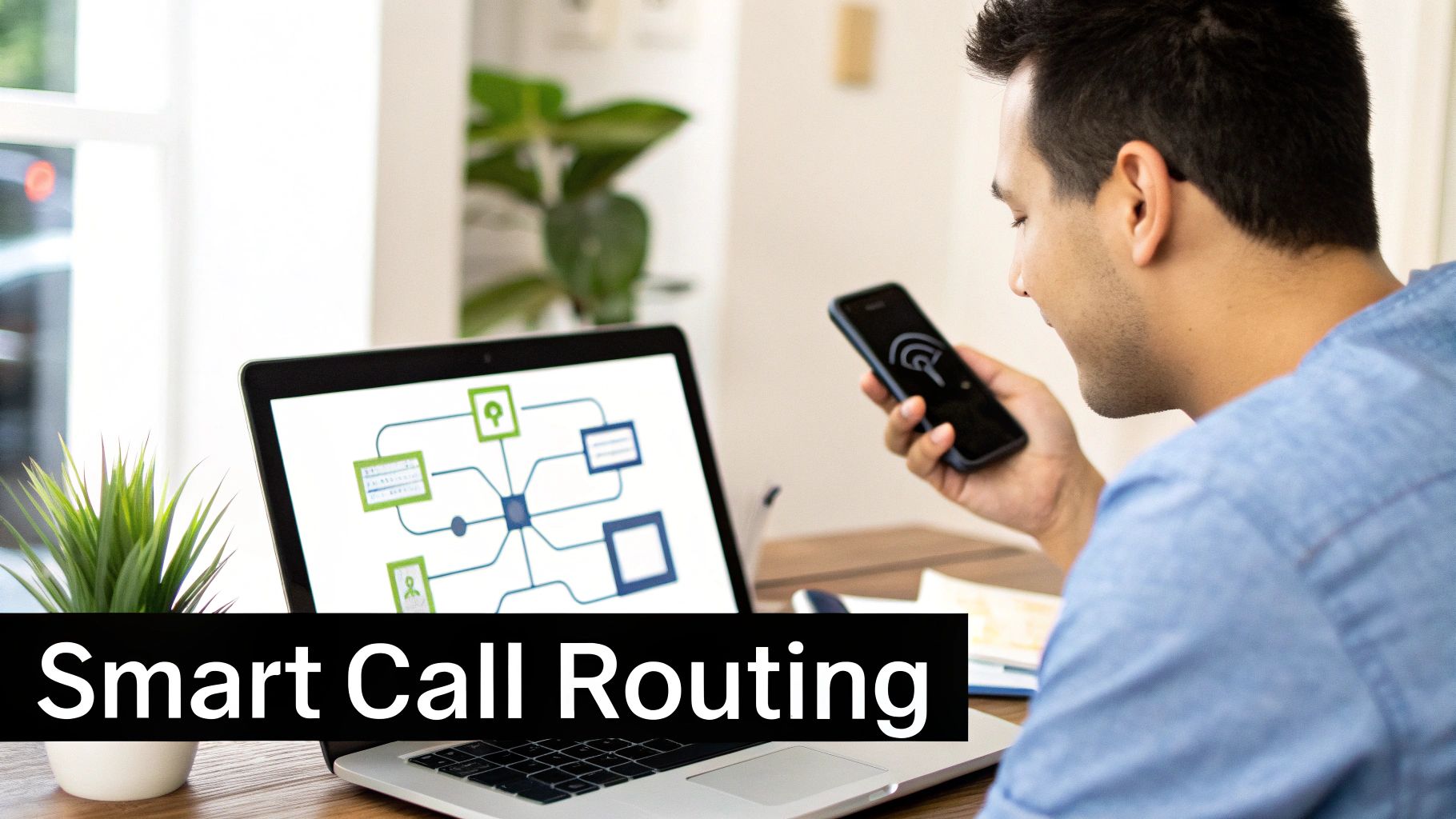Knowing how to forward calls to your cell phone is a simple but incredibly effective way to manage your communications. It’s all about setting up a rule on your landline or VoIP system that automatically sends incoming calls straight to your mobile number.
This simple setup ensures you never miss an important conversation, no matter where you are. The process is often as easy as using star codes like *72 or tweaking a few settings in your phone provider's online portal.

Let's be real—in today's world, being stuck at a desk just isn't the norm for most of us. Call forwarding turns your static office number into a dynamic tool that follows you anywhere. It’s the secret to keeping up a professional front while enjoying the freedom to move around.
Think about a small business owner—maybe a freelance consultant or a local contractor. Their office line is their lifeline. A single missed call could mean losing a valuable new client.
By forwarding calls to their cell, they can field inquiries from a job site, during their commute, or while grabbing materials. This simple trick projects the image of a much larger, more responsive business without any extra overhead. It makes sure every lead gets captured and every client feels heard.
For remote workers, the line between office and personal space can get blurry. Having a dedicated office number creates a professional boundary, but that number is useless if the calls go unanswered.
Forwarding a VoIP office line to a mobile phone bridges this gap perfectly. An employee can jump on a critical client call while working from home or traveling, keeping business moving without a hitch.
Call forwarding is more than just a feature—it's a strategy. It lets people and businesses create a single, reliable point of contact, ensuring they are always reachable when it matters most.
This capability is a cornerstone of modern work, offering some major benefits:
No matter what kind of phone system you're starting with, getting calls redirected to your cell is simpler than it sounds. The exact method changes a bit depending on whether you're dealing with a classic landline, a modern VoIP setup, or even another mobile, but the end goal is always the same: making sure your calls find you, wherever you are.
This infographic gives a great visual of how call forwarding bridges the gap between your work life, remote setup, and personal time, keeping you connected through it all.

It really just shows how forwarding turns your cell phone into the central hub for all your important conversations.
If you're using a traditional landline, the quickest way to get calls sent to your cell phone is by using what are called "star codes." These are universal shortcuts that tell the phone network what to do.
The most common code for what's known as "unconditional call forwarding" is *72.
Here's how it usually works:
To turn it off, you'll typically just dial *73.
Keep in mind that these codes can sometimes vary by carrier. It's not common, but if *72 doesn't work, a quick check of your provider's website should give you the right code.
To make it even easier, I've put together a table with the most common star codes for major US carriers. This can save you a trip to your provider's support page.
Just find your carrier in the list, dial the code, and you're all set. These are handy to have, especially if you manage multiple phone lines.
Today, a huge number of businesses run on VoIP (Voice over Internet Protocol) systems, which offer a ton more flexibility than old-school phone lines. The growth here has been massive—residential VoIP lines in the U.S. jumped from 28 million to 76.6 million between 2010 and 2018. Business lines saw an even bigger leap, going from 6.2 million to 41.6 million in that same period.
This explosion, which you can read more about in Global Tech Stack's research on VoIP statistics and trends, shows just how much businesses have come to rely on these adaptable communication tools.
With a VoIP system, you won't be dialing star codes. Instead, you'll log into your provider’s online dashboard. From there, you just need to find the call management or settings section and plug in your cell number as the forwarding destination.
Pro Tip: The best part about VoIP portals is the advanced rules you can create. For example, I've helped clients set up a "simultaneous ring" where both the desk and cell phone ring at the same time. You can also set it to ring your desk phone three times before forwarding to mobile, which is perfect for catching calls when you're just grabbing a coffee.
Need to forward calls from one cell phone to another? That's probably the easiest setup of all, and it's handled right in your phone's settings.
By following these simple paths, you can easily figure out how to forward calls to your cell phone from pretty much any device you're using.
Knowing how to forward calls is one thing, but the real magic happens when you choose the right type of forwarding. It's not a one-size-fits-all deal, and picking the right option can seriously change how you manage your day-to-day communications.

Think of it like giving instructions to a personal assistant. The simplest command is Unconditional Forwarding. This is the "all-in" approach. As soon as you switch it on, every single call zips straight to your cell phone. Your primary line won't even ring once. This is perfect for days when you know you'll be out of the office but can't afford to miss a thing.
While sending every single call to your mobile works, sometimes you need a more clever arrangement. That’s where Conditional Forwarding shines. It acts like a smart filter, only rerouting calls when certain rules you've set are met.
Let's say you're a freelance graphic designer. You want to sound professional by answering your main business line when you can, but missing a new client lead is out of the question.
With conditional forwarding, you can tell your phone system to:
This conditional method is the key to catching every opportunity without your cell phone blowing up all day. It gives you a much better handle on work-life balance while making sure you're still responsive when it counts.
Finally, we have Selective Forwarding. This option gives you surgical control, letting you forward calls only from specific phone numbers you choose. A parent working from home might use this to make sure a call from their child's school always gets through to their cell, no matter what. All other business calls can follow the normal routine. It's all about prioritizing the calls you absolutely can't miss.
For any modern business, simply knowing how to forward calls to a cell phone is just scratching the surface. The real magic happens when you use smarter tools to create a polished, professional experience for your customers, no matter where you or your team happen to be working.
Today's VoIP systems are so much more than just call redirection. They're packed with intelligent routing features that can turn a solo entrepreneur's cell phone into what feels like a fully-staffed business communication center. This kind of flexibility is a massive reason why the business world has jumped on this technology.
One of the most powerful features you'll find is Find Me/Follow Me. This isn't your grandma's call forwarding; it's a dynamic hunt for you across multiple devices. You get to create a sequence of numbers for the system to try until it finds you.
Picture this: a high-value client calls your main line. The system can be set up to:
This sequential ringing gives every important call the best possible chance of being answered by a real person. It dramatically cuts down on missed opportunities and keeps customer frustration low.
The move to remote work has put these tools in the spotlight. Post-pandemic, VoIP usage shot up by 47% among remote teams, and call volumes on these networks soared by 70%. This shows just how much businesses now rely on tools that seamlessly connect office lines to mobile devices. For more stats on this trend, check out the data from Nuacom.com.
Another game-changer is time-based routing. This feature lets you set up rules that automatically change where calls are sent based on the time of day or day of the week. It’s like having a virtual receptionist managing your schedule.
For example, you can have all calls after 5 PM and on weekends forward straight to your cell phone, while during business hours, they ring your main office line. This is a simple way to automate your work-life balance without ever missing an emergency call.
If you're looking to build a truly professional and highly responsive calling experience for your business, you might want to explore robust business VoIP services. These platforms offer all the sophisticated forwarding and management tools you need to stay connected and in control.
Even the most reliable tech hits a bump in the road now and then. If you’ve set up call forwarding and it’s not working, don’t sweat it—the fix is usually pretty simple. Most of the time, these issues come from small setup mistakes or certain carrier limits you might not even know exist.
First things first, check the forwarding number. Seriously. A single wrong digit is the most common reason for failure. Make sure you’ve entered the entire 10-digit mobile number correctly, area code and all.
If the number is right but your calls still aren't landing on your cell, the issue might be the type of forwarding you've chosen. For example, if you set up conditional forwarding (for when you're busy or don't answer), but your landline's voicemail kicks in too fast, the call never gets a chance to be rerouted.
Here's a pro tip I've learned from experience: try extending the number of rings on your primary line before voicemail picks up. Just adding an extra ring or two is often all it takes for the forwarding rule to activate before your old voicemail grabs the call.
That tiny tweak can finally solve the headache of calls going to the wrong voicemail.
Another common complaint is a noticeable lag before the forwarded call connects. This can be caused by anything from network traffic to the complex handoff between different carriers. While VoIP technology—a market expected to reach $151.21 billion by 2025—has features like silence suppression to help, delays can still happen. To get a better sense of this growing industry, you can check out some interesting business phone system statistics.
If you’ve checked all of the above and are still stuck, try turning the forwarding feature off and then back on again. A quick "reboot" like this can often clear out network glitches and get things working smoothly.
Of course. Here is the rewritten section, crafted to sound like it was written by an experienced human expert, following all your requirements.
Even when you have a good handle on how to set up call forwarding, a few questions always seem to surface. Let's tackle those common head-scratchers so you can get everything running smoothly.
One of the first things people worry about is the cost. Is this going to show up as an extra charge on my bill? For the most part, you can relax. Most modern cell phone and VoIP plans roll domestic call forwarding right into your existing minutes, so there's no extra charge. But if you're working with an older landline service, it's worth double-checking—some of them still tack on a small per-minute fee.
Now, sending calls to an international number is a completely different ballgame. Your provider will almost certainly treat this as a standard international call, which means you’ll be on the hook for international rates. Before you even think about setting this up, dig into your carrier’s fee structure. A quick check can save you from a nasty surprise on your next bill.
Another question I get all the time is, "How will I know if a call is being forwarded?" It's a great question, because you want to know how to answer the phone, right?
Good news: in almost every case, your cell phone's caller ID will show you the original caller's number, not your own business line. This is a huge plus, as it tells you exactly who is trying to get in touch.
Some of the more advanced business VoIP systems give you a bit more control here. They might have a setting that lets you choose whether to display the original caller's number or your main business line. This little feature is incredibly handy. It’s the difference between a professional, "Hello, this is [Your Business Name]," and a casual, "Hey, what's up?" Getting these details right helps you manage your calls like a pro, making sure you’re never caught off guard.
At My AI Front Desk, we take call management a step further. Our AI Receptionist can not only forward calls but also screen them, schedule appointments, and answer common questions, ensuring you only get the calls that truly matter. Learn how our AI solutions can transform your business communications.
Start your free trial for My AI Front Desk today, it takes minutes to setup!








